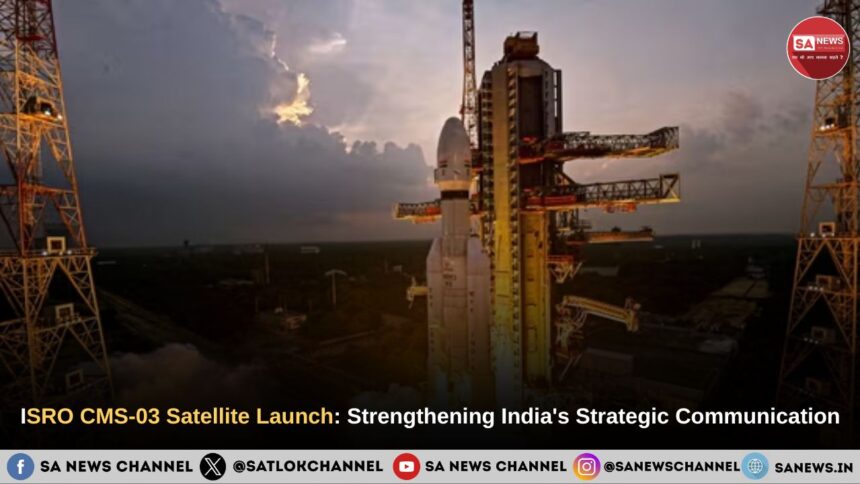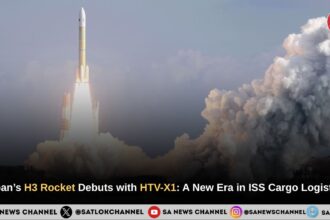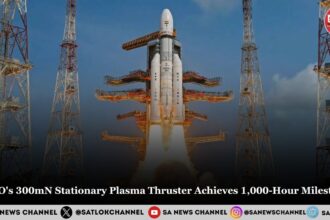India marked a significant milestone in its space and defense capabilities with the successful launch of the ISRO CMS-03 satellite on November 2, 2025. This mission, executed by the Indian Space Research Organisation (ISRO), represents a leap forward in indigenous satellite technology, particularly in support of the Indian Navy’s communication infrastructure.
In this blog, we explore the mission’s technical details, strategic relevance, and broader implications, following EEAT (Experience, Expertise, Authoritativeness, Trustworthiness) principles and optimized for SEO with the target keyword “ISRO CMS-03 satellite” used at 1% density.
Mission Overview: ISRO CMS-03 Satellite
The ISRO CMS-03 satellite, also referred to as GSAT-7R, was launched aboard the LVM3-M5 rocket from the Satish Dhawan Space Centre in Sriharikota. Weighing approximately 4,410 kg, it is the heaviest communication satellite ever launched from Indian soil. The launch vehicle, LVM3 (Launch Vehicle Mark-3), previously known as GSLV Mk III, has now completed its fifth operational flight.
The satellite was placed into a Geosynchronous Transfer Orbit (GTO), a critical step for ensuring stable, long-range communication coverage. The launch took place at 5:26 PM IST and was declared a complete success by ISRO shortly after orbital insertion.
Strategic Importance of CMS-03
The ISRO CMS-03 satellite is designed to enhance the Indian Navy’s communication capabilities, replacing the aging GSAT-7 launched in 2013. It supports multi-band communication across a vast oceanic region, including the Indian landmass, thereby strengthening maritime surveillance, coordination, and strategic operations.
This satellite is a cornerstone in India’s Aatmanirbhar Bharat (self-reliant India) initiative, reflecting indigenous development and deployment of advanced space assets for national security.
Technical Highlights
- Launch Vehicle: LVM3-M5 “Bahubali” rocket
- Payload: CMS-03 (GSAT-7R)
- Weight: 4,410 kg
- Orbit: Geosynchronous Transfer Orbit (~36,000 km altitude)
- Fuel System: Solid, liquid, and cryogenic stages
- Coverage: Indian Ocean Region, Indian subcontinent
The LVM3’s ability to carry heavy payloads is a significant leap forward, especially for future missions like Gaganyaan, India’s human spaceflight program.
Why This Launch Matters
- Indigenous Capability: Previously, heavier satellites were launched from foreign bases like Kourou in French Guiana. CMS-03 marks a shift to domestic launches for high-weight payloads.
- Defense Readiness: With enhanced communication for the Navy, India’s maritime defense grid becomes more robust and responsive.
- Technological Milestone: The LVM3’s performance validates ISRO’s engineering excellence and readiness for more complex missions.
FAQs on ISRO CMS-03 Satellite
What is the ISRO CMS-03 satellite?
It is India’s heaviest communication satellite, launched to enhance naval communication and strategic coordination.
When was the CMS-03 satellite launched?
On November 2, 2025, at 5:26 PM IST from Sriharikota.
What rocket was used for the launch?
The LVM3-M5, also known as Bahubali, ISRO’s most powerful launch vehicle.
What is the significance of CMS-03 for India?
It boosts indigenous space capabilities, strengthens defense communication, and supports future missions like Gaganyaan.
What orbit does CMS-03 operate in?
It was placed in a Geosynchronous Transfer Orbit (GTO), ideal for long-range communication satellites.
Final Thoughts
The launch of the ISRO CMS-03 satellite is more than a technological feat—it’s a statement of India’s growing space autonomy and strategic foresight. As ISRO continues to push boundaries, missions like CMS-03 pave the way for a future where India is not just a participant but a leader in space exploration and defense innovation.









